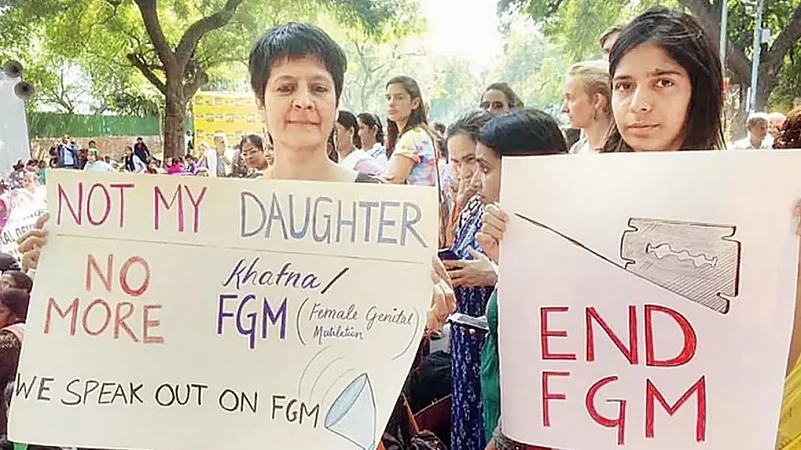During the annual Universal Periodic Review of Human Rights at the 41st United Nations Human Rights Council (UNHRC) session, Costa Rica urged India to take progressive steps to curb the practice of Female Genital Mutilation (FGM) in the country.
On November 10, 25 member states recommended that India undertake enhanced action on this front. This is the first time that India has come under the global body’s radar for the prevalence of FGM, with Costa Rica calling on India to adopt the World Health Organisation’s definition of the practice and act to “criminalise it and implement a national plan to eradicate it.” Here’s all you need to know about India’s stance on FGM:
What is Female Genital Mutilation?
The WHO defines FGM as “all procedures involving partial or total removal of the external female genitalia or other injuries to the female genital organs for non-medical reasons.” Amongst the communities that practice it, it is seen as a coming of age ritual or custom that is meant to maintain the “religious purity” of the female body, by regulating and moderating sexual desires.
There are four types of FGM:
Type I - Partial or complete removal of the clitoris or clitoral hood.
Type II - Partial or complete removal of inner and/or outer labia including pricking/piercing.
Type III - Narrowing of vaginal opening by creating a covering seal.
Type IV - All other harmful procedures to the female genitalia for non-medical purposes.
It is primarily performed on girls on the verge of puberty or sometimes even earlier, between the ages of 1-15. The WHO cautions that more than three million girls are at risk of FGM globally every year.
How prevalent is it in India?
Presently there are no government estimates available to ascertain the incidence of FGM in India. In 2017, in response to a petition in the apex court, the Ministry of Women and Child Development had said that “At present there is no official data or study which supports the existence of FGM in India.”
However, according to a report published by The Guardian in 2018, in India, Type I and Type IV procedures of FGM are prevalent amongst the Bohra sect of Shia Muslims, primarily in the states of Maharashtra, Kerala, Rajasthan, Gujarat, and Madhya Pradesh.
The report referred to a survey conducted by a WeSpeakOut against FGM, a coalition of Bohra women who commissioned the study, out of 83 female respondents, 75% had suffered some form of FGM, locally referred to as ‘khatna’ or ‘khafd’ in their early years. Mullanis, or traditional cutters perform the ritual cutting, which is a harrowing experience for the women.
What are the dangers associated with FGM?
The Guardian quotes Dr Sujaat Jenuddin Vali, a gynecologist who examined Bohra women during the course of the study, who revealed that “Half of them feel some kind of irritation, while 30% either feel discomfort while walking/urinating or have lost sensitivity in the area.”
Besides the lifelong physical and psychological trauma that FGM is associated with, in the short term, the surgery causes excruciating pain, excessive bleeding, and can cause fever, infections, shock or even death. In the longer run, it can cause urinary and vaginal complications, and may even significantly complicate childbirth.
Furthermore, it curtails women’s sexual choices. Aaerfa Johari, a Bohra journalist, who underwent FGM at the age of seven, told The Guardian that “We all were minors and unable to make our own choice. How can anyone say that her sexual life couldn’t have been more pleasurable? Nobody can give me that guarantee and that’s what frustrates me.”
Is there a law banning FGM in India?
Presently, there is no legislation that bans the practice in the country. In fact, the government’s denial to acknowledge its prevalence has stalled any such effort. Another hiccup in the enactment of a law is its conflict with freedom of religion enshrined under Articles 25 and 26 of the Constitution.
In 2017, a Public Interest Litigation filed in the Supreme Court by Human Rights activist Sunita Tiwari raised the issue. The PIL contends that the practice is violative of women’s constitutionally guaranteed right to equality (Article 14), protection against gender based discrimination (Article 15), right to life, bodily integrity and privacy (Article 21).
It also highlights that the right to freedom of religion is restricted on grounds of public order, health, and morality. Moreover, Tiwari’s advocate has submitted that the practice of FGM has no religious sanction in the Quran. In fact, the International Conference on Population and Reproductive Health in the Muslim World, held in 1998 at Al Azhar University, Egypt, had recognised that harmful practices such as FGM emanate from a misunderstanding of Islamic tenets.
The defendants in the case led by the Dawoodi Bohra Women’s Association for Religious Freedom have, however, contended that ‘khatna’ is the practice of circumcision to attain “religious purity,” which is undertaken by both men and women in the community and is thus not discriminatory. They oppose a ban on the practice and reiterate that the right to perform religious practices is constitutionally protected under Articles 25 and 26.
So what has been the progress on the legal front?
In 2018, a bench of judges led by then Chief Justice of India Ranjan Gogoi admitted the PIL and expressed concern over the harmful effects of the practice. Justice Gogoi opined that FGM has to scrutinised from the lens of the Protection of Children from Sexual Offences (POCSO) Act since “these petitions have been filed by women. And if they do not want it, then it cannot be imposed.”
The bench further upheld that even if FGM is defended as an “essential religious practice,” does not mean it is above constitutional morality. “If we do not go by the constitution, then morality is left to the mob,” the order said.
Based on a majority verdict, the PIL was subsequently clubbed with a batch of petitions addressing women’s rights in relation with religious freedoms: with Hindu women’s entry into the Sabarimala temple, Muslim women’s entry into mosques, and the entry of Parsi women married to non-Parsis into fire temples. In November 2019, the batch of petitions were referred to a seven judge bench.
Currently, since the Indian Penal Code (IPC) does not recognise FGM as a crime, the complaints are filed under Section 326 (voluntarily causing grievous hurt) which entails imprisonment of upto ten years.
Are there any international precedents?
Since 2003, the UN observes February 6 every year as the International Day for Zero Tolerance to FGM. The Sustainable Development Goals call for its elimination before 2030. The WHO has tagged FGM as a ‘grave human rights violation,’ while a 2012 UN General Assembly has called for the worldwide elimination of FGM.
In this regard, more than 30 countries including the United States of America, the United Kingdom, and 27 African nations have banned the practice.
Activists insist that India must not look at a human rights issue through the lens of religious freedom when assessing its legality. Enacting a law to ban FGM will be the first step in tackling a deep rooted social issue.


























